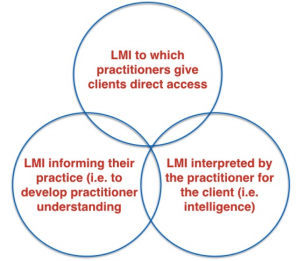Choosing amongst sources of LMI
Learning objective
- To identify criteria that can be applied when choosing amongst sources of LMI.
LMI sources in practice
You will know from your own practice or from following other learning units on this site that finding and making sense of reliable and relevant Labour Market Information is not simple.
The following diagram attempts to capture some of the complexity related to the ways that career practitioners will require access to different types and sources of LMI, sometimes overlapping, depending on their immediate requirements.

Careers practitioners typically feel pressurised, with limited time to research information. Consequently, LMI providers need to be aware that information: must be easily accessible; available in a simple form; and in accordance with the underpinning principles, which include:
- Ethical: adherence to the core ethos of equality of opportunity for all and compliance with related legislation.
- Impartial: all LMI produced for the guidance/counselling process does not promote one sector, in a competitive manner, as superior to any other, or mask an economic decline.
- Accessible: addressing physical limitations as well as the ability to understand particular levels of complexity.
- Robust: ensuring reliability, comprehensiveness and currency.
- Relevant: to the needs of practitioners in their guidance work with clients.
A practitioner guide to the efficacy and quality of LMI
In the first unit, the distinction was made between ‘hard’ and ‘soft’ information, as well as between labour market information and intelligence.
The following checklist provides a guide for practitioners in assessing the efficacy and quality of LMI.
Choosing between sources of LMI
| Who has produced the LMI?
Think about:
|
|
| How was the LMI collected?
Think about:
|
|
| How is the LMI data disaggregated and classified?
Think about the:
|
|
| Is the LMI up-to-date?
Think about:
|
|
| Is the LMI fit for purpose?
Think about the:
|
Further reading and reflection

Think about your use of LMI in practice:
- Focusing on your most common sources of LMI, how confident are you that they comply to the underpinning principles above?
- Use the checklist to assess the provenance and value of these data for use in your practice.
Read a GMT interview with Professor Jenny Bimrose: Labour market information: pivotal in careers advice and guidance.
Go to the next unit: Understanding replacement demand and skills shortages
